
131
https://doi.org/10.52111/qnjs.2025.19210
Tạp chí Khoa học Trường Đại học Quy Nhơn, 2025, 19(2), 131-146
Tác động của các đặc điểm tính cách nhà lãnh đạo
đến sự tin tưởng của nhân viên trong các tổ chức
phi chính phủ tại Việt Nam
Dương Thị Hoi Nhung1,*, Đon Phương Anh2
1Khoa Quản trị kinh doanh, Trường Đại học Ngoại thương, H Nội, Việt Nam
2Tổ chc Pht triển H Lan SNV, Việt Nam
Ngy nhận bi: 05/12/2024; Ngy sửa bi: 03/03/2025;
Ngy nhận đăng: 11/03/2025; Ngy xuất bản: 28/04/2025
TÓM TẮT
Nghiên cứu này nhằm mục đích khám phá tác động của các đặc điểm tính cách của nhà lãnh đạo dựa trên
mô hình năm đặc điểm tính cách đến lòng tin của nhân viên. Dữ liệu được thu thập thông qua khảo sát trực tuyến
qua email với 212 mẫu hợp lệ. Những người trả lời làm việc tại các tổ chức phi chính phủ có trụ sở tại Hà Nội,
Việt Nam. Nghiên cứu sử dụng các phương pháp định lượng với kỹ thuật phân tích hồi quy để kiểm định các giả
thuyết. Kết quả cho thấy sự dễ chịu, tận tâm, hướng ngoại, sẵn sằng trải nghiệm có tác động tích cực đến lòng tin
của nhân viên, trong đó sự tận tâm của nhà lãnh đạo có ảnh hưởng đáng kể đến lòng tin của nhân viên. Ngoài ra,
tính cách bất ổn tâm lý của nhà lãnh đạo có tác động tiêu cực đến lòng tin của nhân viên. Các phát hiện không ch
đóng góp về mặt lý thuyết mà còn cung cấp những hàm ý thực tiễn để cải thiện các đặc điểm của nhà lãnh đạo
trong các tổ chức phi chính phủ và đề xuất các chính sách thúc đẩy môi trường lãnh đạo đáng tin cậy để củng cố
lòng tin của nhân viên.
Từ khóa: Tính cch c nhân, mô hình năm đặc điểm tính cch, sự tin tưng.
*Tc giả liên hệ chính.
Email: nhungdth@ftu.edu.vn
TRƯỜNG ĐẠI HỌC QUY NHƠN
KHOA HỌC
TẠP CHÍ

132 Quy Nhon University Journal of Science, 2025, 19(2), 131-146
https://doi.org/10.52111/qnjs.2025.19210
QUY NHON UNIVERSITY
SCIENCE
JOURNAL OF
Impact of leader personality traits on employee trust
in leaders of non-governmental organizations in Vietnam
Duong Thi Hoai Nhung1,*, Doan Phuong Anh2
1Faculty of Business Administration, Foreign Trade University, Hanoi, Vietnam
2SNV Netherlands Development Organization in Vietnam
Received: 05/12/2024; Revised: 03/03/2025;
Accepted:11/03/2025; Published:28/04/2025
ABSTRACT
The study aims to explore the impact of the personality traits of leaders based on the Big five traits model on
employee trust. Data were collected through an online survey via email with 212 valid samples. The respondents
work at non-governmental organizations located in Hanoi, Vietnam. The study uses quantitative methods with
regression analysis techniques to test hypotheses. The results show that agreeableness, conscientiousness,
extraversion, openness to experience have a positive impact on employee trust, in which conscientiousness has
a significant influence on employee trust. In addition, neuroticism has a negative impact on employee trust. The
findings not only contribute theoretically, but also provide practical implications to improve the traits of leaders
in non-governmental organizations, and recommend policies to promote a trustworthy leadership environment to
strengthen employee trust.
Keywords: Personality traits, big five traits model, trust.
*Corresponding author.
Email: nhungdth@ftu.edu.vn
1. INTRODUCTION
In the dynamic and professional context of
organizations, trust plays an important role in
the complex interaction between leaders and
employees, helping to enhance performance,
promote positive attitudes, and support
teamwork.1 Workers are more likely to show
dedication, communicate honestly, and actively
participate in the accomplishment of company
objectives when they trust their leaders.2 On
the other hand, a lack of trust can result in
mistrust, a defensive mindset, and hesitancy in
sharing resources and information, which can
lower operational performance and even cause
an organization to fail. Scholars are actively
working to unravel the complex dynamics of
trust in organizational dynamics, with the goal of
understanding how to foster trust in leadership.
Understanding the complex aspects of this
crucial relationship and determining the elements
that promote trust in leaders are of common
interest to them.3 Barrick and Mount discovered
the role of individual leader personality traits
in shaping employee trust, and believed that
understanding this interaction mechanism is
essential to developing strategies to promote
trust in organizations.4 In addition, Sicora's study
also explored the complexity of personality traits
and leadership styles, thereby examining how
the leader-employee relationship contributes to
the trust that forms between them.5 In Vietnam,
the study of personality traits has received

Quy Nhon University Journal of Science, 2025, 19(2), 131-146 133
https://doi.org/10.52111/qnjs.2025.19210
QUY NHON UNIVERSITY
SCIENCE
JOURNAL OF
attention from researchers in recent years. These
studies mainly focus on the relationship between
personality traits and employee creativity,6
personal financial investment intentions,7
employee commitment to the organization,8
and social entrepreneurship intentions.9 All of
these studies were conducted at businesses or
organizations operating in Ho Chi Minh city.
However, studies on the relationship between
personality traits and trust in leader-employee
relationships have not received much attention
in Vietnam.
This study primarily aims to analyze the
impact of leaders’ personality traits on employee
trust within non-governmental organizations
(NGOs) in Vietnam. Non-governmental
organizations play a key role in addressing
social challenges such as poverty, environmental
issues and health care in Vietnam. NGOs may
engage in charitable endeavors, offer much-
needed services, or empower society by raising
awareness of their potential to exert control
over individuals' lives. They may focus on a
specific city, neighborhood, country, or region.
NGO leaders are uniquely positioned to tackle
society’s most pressing issues across various
domains. However, NGOs deal with more
erratic externalities and resource constraints
compared to for-profit companies.10 In order
to handle the uncertainty, complex tasks and
responsibilities require NGOs' leaders to possess
additional traits including personality and
competency to encourage innovative resolution.
Additionally, leaders need to have traits and
qualities that encourage followers to engage
with the organization and voluntarily share their
expertise. The follower's commitment to stay in
the relationship depends on the quality of the
leader-follower relationship.11 Followers are
more likely to acquire mutual trust in their leader
if they have a congenial relationship between
leader and followers, and this relationship may
be positively correlated with organizational
members' commitment. Thus, trust is an essential
foundation in organizations, not only in external
relations with donors or partners, but also within
the organization. Trust is one of the most vital
forms of capital a leader has today. In the face
of global uncertainty and economic upheaval,
people increasingly look to their employers and
corporate executives for the truth rather than
their institutions. Trust encourages and promotes
cooperation and teamwork between employees
and leaders. However, there is still a lack of
significant empirical data on the impact of
leaders' personality traits of leaders on employee
trust in Vietnam, especially in NGOs. Therefore,
this study was conducted to address the existing
research gaps by examining and understanding
the correlation between leader personality traits
based on McCrae and John's big five traits model
and employee trust in leadership.12 This study
goes beyond current research paradigms by
emphasizing the interaction between employees
and their leaders and focusing on the trust
dynamic within an organizational framework.
The objective is to investigate and pinpoint
the aspects of a leader’s personality that are
crucial in forming and impacting trust in leader-
subordinate relations in Vietnamese NGOs.
Based on the theoretical foundation of social
exchange and leader-member relationships,
the findings of the study will provide valuable
insights into theory and practical applications
through proposing policy implications to
improve leadership effectiveness in NGOs
operating in Hanoi, Vietnam.
The structure of the article includes four
parts: theoretical background and hypothesis
development; methodology referring to scale
development, questionnaire construction, data
collection and analysis; presentation of research
results; theoretical and practical contributions;
conclusions, limitations and future research
directions.
2. THEORETICAL BACKGROUND AND
HYPOTHESIS DEVELOPMENT
2.1. Theoretical background
2.1.1. Social exchange theory
Social exchange theory is one of commonly-
used theoretical frameworks for individuals who

134 Quy Nhon University Journal of Science, 2025, 19(2), 131-146
https://doi.org/10.52111/qnjs.2025.19210
QUY NHON UNIVERSITY
SCIENCE
JOURNAL OF
control their social interactions by weighing the
advantages and disadvantages of doing so from a
self-interested perspective.13 When transferring
resources with others, people aim to reduce
costs and increase advantages.14 Since people
may interact with the expectation of reciprocity,
these advantages do not necessarily have to
be tangible.15 In these kinds of interactions,
people provide a hand to others with the general
expectation of receiving something in return,
such as obtaining resources through social
reciprocity. Konovsky and Pugh16 indicated that
trust is rooted in an individual's social exchange
process, accompanied by employees' belief in the
manager's commitment to fulfilling long-term
obligations. Organ17 notes that employee trust
in a leader motivates increased mutual respect,
while also encouraging behaviors beyond work
requirements, such as organizational citizenship
behavior.
2.1.2. Leader-member exchange theory
Since its inception by Dansereau et al.,18 leader-
member exchange (LMX) theory has evolved
from a focus on mutually dependent relationships
and the interdependent functioning of dyadic
relations inside an organization. The fundamental
tenet of LMX theory is that a dyadic relationship
between a supervisor and a subordinate will
unavoidably develop, and that this relationship
will manifest as a leader-member exchange
relationship of either high or low quality. The
LMX theory emphasizes trust as a motivator
that contributes to motivating employees to
invest more effort by demonstrating innovation
and willingness to take on more responsibility.
Shapiro asserts that trust facilitates good
coordination and control in the work process
to achieve organizational goals,19 similar to the
conclusions of Granovetter and Ferris et al.20,21
In addition, Dirks and Ferrin22 also demonstrated
that in an environment that promotes trust,
employees will work cooperatively with
a positive attitude, thereby improving
performance and quality of work. Beehr et al.,23
acknowledged that the best communication,
trust, and responsibility are always present. They
also discovered that when supervisors and their
subordinates have a high-quality leader-member
exchange, the supervisors are effective and
highly satisfied with their work routine and job,
leading to productive behavior and, eventually,
organizational success. This theory helps explain
the impact of leader personalities on promoting
or inhibiting employee trust.
2.1.3. Personality traits
Personality is the biological and cultural makeup
of a person, a unique combination of heredity and
environment. In terms of evolution, personality
is a unique combination of biology, psychology,
and sociology through natural and social
selection to form the individual's worldview.24
Barrick and Mount4 further highlight the critical
role of personality assessments in the workplace,
emphasizing the strong link between an employee's
personality traits and their behavior within the
organization. This connection underlines the
necessity of recognizing and valuing individual
differences, as these are instrumental in crafting
a diverse organizational culture. One of the most
popular personality trait models, recognized and
used by many studies in sociological research,
is the Big five-personality model developed by
McCrae and John.12 The most prominent features
of personality may be described by a five-factor
model of personality, referred to as the Big Five
traits.25 Under analytic investigations of the current
personality inventory, expert conclusions about
the dimensionality of existing measures, the five-
factor structure have been retrieved.12 Research
conducted in numerous nations has demonstrated
the cross-cultural generalizability of the five-traits
structure.12 There is evidence that the Big Five
traits are stable throughout time and heritable.12
One of the most studied and well-established
taxonomies of personality is the Big Five traits,
which includes extraversion, agreeableness,
openness to experience, conscientiousness, and
neuroticism.26 In personality psychology, these
characteristics are seen to be fundamental trait
dimensions.26
The first trait, neuroticism often equated
with emotional instability, is a trait marked by

Quy Nhon University Journal of Science, 2025, 19(2), 131-146 135
https://doi.org/10.52111/qnjs.2025.19210
QUY NHON UNIVERSITY
SCIENCE
JOURNAL OF
a tendency to experience negative emotions
like tension, worry, and anxiety.12 The second,
extraversion is characterized by sociability,
assertiveness, and enthusiasm. Barrick and Mount4
indicated that extraverts are talkative, optimistic,
and energetic, often actively engaging in social
interactions and displaying dynamism. McCrae
and John12 define agreeableness as a personality
dimension that encompasses traits like kindness,
compassion, and altruism. Conscientiousness,
the fourth component, encompasses traits like
adaptability, impulsivity, and organization as
well as duty.4 Finally, openness to experience, as
defined by Goldberg,25 encompasses curiosity,
open-mindedness, emotional awareness, and
intellect, orienting individuals towards new
experiences and ideas.
2.1.4. Trust
In academic studies, the term "trust" has been
defined in a variety of ways and is frequently
interpreted in terms of vulnerability and risk.
There are substantial stakes in every trusting
connection, and it is important to recognize and
accept the risks involved.27 A trait shared by all
trust situations is a readiness to take risks.28 The
concept of trust used in this study is consistent
with that proposed by Mayer et al.29 Trust is a
willingness to be vulnerable, which is a notion
that fits in well with the investigation of how
a leader's personality trait affects an employee
trust. The /use of this concept emphasizes how
crucial vulnerability is to the dynamics of trust
in a leadership context. Leaders, through their
personality traits, significantly shape the level of
vulnerability employees are willing to accept and
feel comfortable embracing, thereby molding
the trust they place in their leaders.
2.2. Hypotheses development and proposed
research framework
2.2.1. Leader openness to experience and
employee trust in their leader
Openness to experience is a personality trait
characterized by curiosity, openness, emotional
awareness, and a desire to learn, which orients
individuals toward new experiences and ideas.23
This personal trait is essential for leaders to
overcome challenges, foster innovation, and
adapt to changes in a dynamic environment.
Previous research has shown that leaders with
this personality trait tend to embrace new ideas
and demonstrate flexible decision-making.30-31
These qualities promote an organizational culture
that values transparency, encourages dialogue,
creativity, and embraces change, which in turn
fosters employee trust. Sicora emphasized that
leaders with high openness to experience are
often perceived as more trustworthy because
they manage complex situations effectively with
creative solutions.5
H1: Leader openness to experience
positively influences employee trust in their leader
2.2.2 Leader conscientiousness and employee
trust in their leader
Conscientiousness includes personality traits
such as diligence, accuracy, and a strong sense
of duty.4 Leaders who exhibit high levels of
conscientiousness are often perceived as well-
organized, trustworthy, and morally committed.32
These traits are necessary to build trust based
on Mayer et al.’s organizational trust theory.29
Several recent studies support the strong link
between conscientiousness and a leader’s ability
to be trusted, while others confirm its role in
fostering trust within organizations.5,33,35 Thus,
the hypothesis 2 for this research is:
H2: Leader conscientiousness positively
influences employee trust in their leader
2.2.3. Leader extraversion and employee trust in
their leader
Extraversion is a personality trait characterized
by sociability, assertiveness, and enthusiasm.4
This trait aids leaders in effective communication
and relationship building – two key components
of trust. Bono and Judge30 concluded in their
previous research that extraverted leaders are
particularly good at creating a team environment
that fosters and nurtures positive relationships.
Shahzad et al.,34 also successfully demonstrated
a positive correlation between extraversion and
a leader’s ability to gain trust. Additionally,




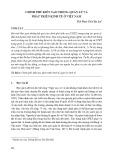
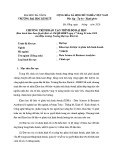
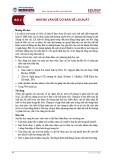
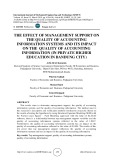
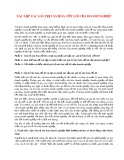
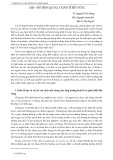
![Giáo trình Nền kinh tế công cộng [mới nhất]](https://cdn.tailieu.vn/images/document/thumbnail/2018/20180531/hpnguyen13/135x160/4911527762697.jpg)















